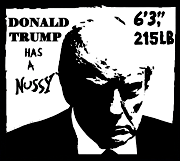|
MeinPanzer posted:In Scotland, where I just bought a house, all offers are final, all bidding is blind, and you have to pay any difference between listed price and accepted offer in cash. Like actual cash? if someone lists for $100k and the accepted offer is $120k, the buyer needs a duffle bag of cash ($20k) to pay the difference?
|
|
|
|

|
| # ? Apr 27, 2024 11:52 |
|
$20K is a thick envelope.
|
|
|
|
Subjunctive posted:$20K is a thick envelope. I had a $1k envelope recently and it felt like I was carrying a loving bomb. Couldn’t fold it into my wallet either.
|
|
|
|
Arivia posted:I had a $1k envelope recently and it felt like I was carrying a loving bomb. Couldn’t fold it into my wallet either. guess you should have filled a duffel bag instead! ($20K in $100s is less than half a pound of notes. you don’t put it in your billfold, but you don’t need straps to help you lift it) Subjunctive fucked around with this message at 15:37 on Mar 10, 2024 |
|
|
|
this is very important to me
|
|
|
|
I do think public bids would go a ways towards deflating that gap between asking and accepted. When we were buying in 2021, the accepted logic was that the going price would be 100-150k above asking, but you never got any sense at all of what others were actually bidding, just the winner.
|
|
|
|
public during the bidding process would just cause everything to hinge on how quickly the selling agent registered the bids, and they already play games with registering the offers as they’re supposed to Vickrey auctions (where the winner pays the second-highest bid) seem like they would be a good fit for this, and they are a Canadian invention!
|
|
|
|
Huh, $1000 notes aren't legal tender any more as of 2021.
|
|
|
|
drat what am i gonna do with all these 1000 dollar bills i have laying around
|
|
|
|
Well Mulrooney is dead so,
|
|
|
|
Funny wikipedia tidbit: The Birds of Canada series of banknotes was going to have the spruce goose on the $1000, butquote:its nickname “fool hen” was “considered too controversial”.
|
|
|
|
Spruce grouse, not spruce goose. The spruce goose is an airplane.
|
|
|
|
MeinPanzer posted:In Scotland, where I just bought a house, all offers are final, all bidding is blind, and you have to pay any difference between listed price and accepted offer in cash. It’s also really hard to get mortgages for more than the independent valuation of a property. I have friends who bought an apartment at a co-op in Scotland and it sounded like heaven compared to here. Including the fact that these apartments were substantial, well built, not-piece-of-poo poo honest to god apartments.
|
|
|
|
By cash I mean you need to have the funds to hand--you're not allowed to formally borrow the difference between listed price and accepted offer (and the lender will need to know where you are getting the funds from to approve you for a mortgage).Dreylad posted:I have friends who bought an apartment at a co-op in Scotland and it sounded like heaven compared to here. Including the fact that these apartments were substantial, well built, not-piece-of-poo poo honest to god apartments. There was a huge amount of residential construction here up until Thatcher, basically--much more than in Canada--and a lot of that housing is relatively well built (even the council housing, aka projects) and so has remained circulating since. There's no shortage of 2 and 3-bedroom houses.
|
|
|
|
spotted in Mississauga  wtf is a bunkie and how is it going to solve our housing woes?
|
|
|
|
Cold on a Cob posted:spotted in Mississauga https://bunkielife.com/bunkie-with-loft/ A sub-200qsft "house" apparently.
|
|
|
|
One way to get your boomerang college graduate kid out of the house.
|
|
|
|
Bunkies are more of a thing for like, cottages in my experience. Especially for people splitting them with big extended families. Can't exactly add a couple new bedrooms on some old rear end cottage easily but throwing a small wood prefab structure that's basically just a few bunk beds for the kids is easy enough, especially if you aren't planning to be there in the winter and don't need to heat/winterize it.
|
|
|
|
A bunkie is a tiny house on the same property as a normal house, like a detached in-law suite or habitable shed. Imagine turning your illegal 6-plex into a 7-plex!
|
|
|
|
I don't understand those ads strapped to posts on car-choked roads. Who's calling these guys based on what's usually a single image with no information about who they are? And at most you've got the length of a stop light to think about it, do you take a photo of the ad? People keep putting them up though so I guess they must get some return?
|
|
|
|
Bunkies are buildings that are below the permit requirements (10sq meters, or ~121sqft) so that you can buy the kit without telling your local permit office and have to get them inspected and approved.
|
|
|
|
I've actually had much better luck hiring for manual work like window cleaning, parking lot painting, etc. from random signs than from google. At least you know there is an actual person, physically located in your area who is willing to come out to your site to give a quote which is not the case ~90% of the time online.
|
|
|
|
Muscle Tracer posted:A bunkie is a tiny house on the same property as a normal house, like a detached in-law suite or habitable shed. Imagine turning your illegal 6-plex into a 7-plex! It was one of those wooden garden sheds that looks like a tiny house. Apparently they had run plumbing and power to it. The owners originally told neighbours that it was a workshop for the husband but then people saw a young woman leaving everyday in the morning and coming back in the evening. Someone asked her one day what was going on and she said that she was renting it. It was something like this: 
|
|
|
|
Young coworker was looking at a rental apartment in Coquitlam area. 2 mattresses in the hallway, 2 in each of the 2 bedrooms. People will never have to sell if we let them pack and stack people.
|
|
|
|
If you live in a shed on a Homeowner's property, that's Very Good. But if you live in your own tent on public land... that's very, very bad indeed. It's important to create value, it is our purpose in life.
|
|
|
|
PT6A posted:If you live in a shed on a Homeowner's property, that's Very Good. But if you live in your own tent on public land... that's very, very bad indeed. It's important to create value, it is our purpose in life. No landlord to collect rent if you're in a tent. Tragic.
|
|
|
|
https://x.com/canadianpolling/status/1767230531190554799?s=46&t=ruJSzwqECRxfc3oePbtIng
|
|
|
|
NIMCism
|
|
|
Purgatory Glory posted:Young coworker was looking at a rental apartment in Coquitlam area. 2 mattresses in the hallway, 2 in each of the 2 bedrooms. People will never have to sell if we let them pack and stack people. The trick is to report them to insurance companies because normally you can't have more than 3 unrelated people in 1 unit without more expensive insurance. If you don't like scummy landlords.
|
|
|
|
|
Chillyrabbit posted:The trick is to report them to insurance companies because normally you can't have more than 3 unrelated people in 1 unit without more expensive insurance. Good, I think that these international students get roped in and convinced they'll be deported if they rock the boat though.
|
|
|
|
https://twitter.com/cafreeland/status/213284707633344512 e: I'm senile and thought the tweet was recent, but it's from 2012. just ignore. I was mostly surprised at freeland saying that while in function, but it appears it's not the case. Popoto fucked around with this message at 01:18 on Mar 13, 2024 |
|
|
|
Purgatory Glory posted:No landlord to collect rent if you're in a tent. Tragic. Why would you deprive a landlord, whose awful garden shed is empty and wanting, to live in a tent? Disgraceful behaviour, really. How will that help The Market?
|
|
|
|
Has Coquitlam city council been secretly luring bears to the city for years in order to make it unsafe to live in tents so they can boost sales of laneway houses? I guess we'll never know
|
|
|
|
Squibbles posted:Has Coquitlam city council been secretly luring bears to the city for years in order to make it unsafe to live in tents so they can boost sales of laneway houses? I guess we'll never know I actually double checked and the coworker was in Abbotsford, not Coquitlam when he saw the slumber party set up in a rental.
|
|
|
|
There were a lot of those furry assholes last summer, your theory scans
|
|
|
|
letting people sub-develop their yard into slum residences is probably the closest we'll ever come to fixing suburbs, short of a continent-wide rash of large fires which hey, definitely might happen first
|
|
|
|
Rockstar Massacre posted:letting people sub-develop their yard into slum residences is probably the closest we'll ever come to fixing suburbs, short of a continent-wide rash of large fires TBF the more formal version of this is already well underway, at least in places like Vancouver. Laneway houses and legal basement suites have been part of the mix for over a decade, and the new hotness is multiplexes that look like SFH to keep the NIMBYs happy. Vancouver just passed laws allowing the latter, and the province of BC passed laws requiring most other municipalities to do the same.
|
|
|
|
Lead out in cuffs posted:the new hotness is multiplexes that look like SFH to keep the NIMBYs happy.
|
|
|
|
The house next door to us is a triplex (2 floors + basement suite) and yeah, I don't think you would have any idea off-hand that that's the case. My neighbourhood is 1950s-era and plenty of the SFH have been converted into multi-unit buildings over time. Seems like a decent way to increase density without having to tear-down stuff. On the other hand they did pave over the entire backyard to provide 3 parking spaces so no one living there has access to a decent green area. Another victim of car supremacy.
|
|
|
|

|
| # ? Apr 27, 2024 11:52 |
|
Aside from the much needed housing, the best part about Sen̓áḵw is absolutely how much it makes the residents of Kits Point furious. quote:Vancouver’s new mega-development is big, ambitious and undeniably Indigenous
|
|
|








































